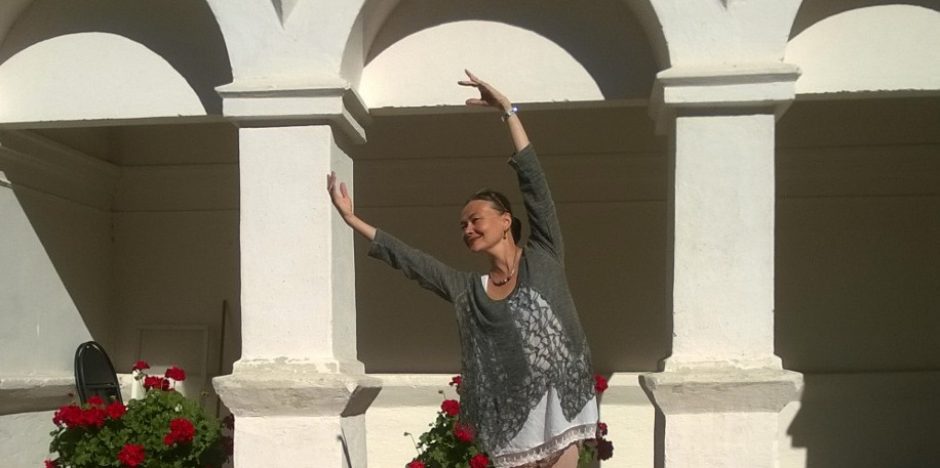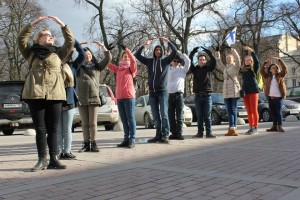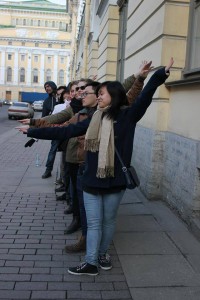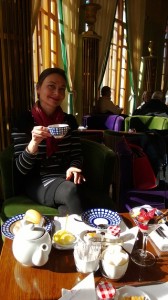What could be a more appropriate meeting point for our walking tour than Pushkin´s statue at the Arts Square in Saint Petersburg on a sunny afternoon in late March. I have named the tour Bridges, Poets and Ballerinas, as it turns out there will be a lot of ballet, much less poetry. And the bridges of course refer to the Venice of the North. Pushkin is very soon to be dismissed in favor of Mikhailovski Theatre. Here I saw my very first Russian performed ballet in the late 70’s, after I had been callously dismissed from Kirov (Marinskij) by the ubiquitous guardian ladies. “No malinkij allowed in the evening performance.” Thus, I have always had a preference for Mikhailovskij Theatre. Later, when I studied in Palucca Schule Dresden summer academy in 1990, the head ballet teacher was Ludmila Safronova (b. 1929), long-term Prima Ballerina of this very theatre. Another strong reason for my preference for this particular venue. Finally, there was also simply a practical consideration, the interactive ballet walking tour would have been far too long if I had included the Marinskij in the itinerary.
Here we are finally, TOBBA13 International Tourism students, after having danced together all year in various movement improvisation workshops. How I ended up here is a long story – I am not even supposed to be here as I am not officially employed in the study programme. Yet, I feel that I am in the perfectly right place as this is the capital of classical ballet. So dear TOBBA13 dancers, lets learn the five basic positions of the feet. Madame Safronova is still actively teaching and strikes a perfect fifth position when demonstrating a movement à la barre. However, I advice you to stick to open third position, otherwise you will wreck you knees in no time. And now we’ll lift the arms into third position. Watch out, you are not supposed to lift your shoulders to your ears! There are pictures taken, also by some random tourists stopping by to observe this peculiar performance.
The next stop is Architect Rossi Street 2. No distance whatsoever on the map, however we end up walking quite far, crossing the street at the corner of the Eliseev store and walking past the neoclassical Aleandriskij Theatre. In photos the Rossi Street is always pictured with the theatre elegantly closing the perspective. Looking the other way we are mainly spotting cars everywhere. Can it really be here, the prestigious Vaganova Academy, the most prominent ballet school in the world? Yes, there is the plate all in Russian. These doors have seen Pavlova, Karsavina, Nijinsky, Nurejev, Makarova, Baryshnikov, Zakharova and Vishneva passing through. The list of names is endless. The students are listening reverently when I tell them that Ludmila Safronova was one of the last students of the legendary ballet pedagogue Agrippina Vaganova. So even I have a connection, yet small one, to this sacred place. We see a dainty first-year student skipping out of the building and being picked up by car. They are all so cloned, yet someone will become a star of international class. My own ballet teacher used to say that it takes 20% talent and 80% work to become a ballet dancer. And then she would viciously add “of which my colleague ballerina X is a clear proof”.
Are you still with me? We are walking down the endless Nevskij Prosect and turn left to reach Isak’s Square, still some walking left. This is definitely not the tour for American cruise tourists. This is more likely meant for ballet fanatics. Finally there, facing Hotel Astoria and its annex L’Angleterre. Now it’s time for the second poet of the tour, Sergej Esenin. The one who hung himself in L’Angleterre after having written his farewell poem in blood. This short summary is of course only a pretext for transferring the attention to his far more luminous wife, Isadora Duncan, the mother of modern dance. She used to hang around in Astoria in her Greek gowns. “Je vais à la gloire”, were her last words before getting killed in Nice when her long scarf got entangled around the wheels of an open sports car. And still my brave TOBBA13 students have some energy left to pose in Duncan manner, as she used to when dancing to La Marseillaise. Time for the final Reverence! It has been a long day of walking, but now the topography of the city is forever imprinted in our muscles.
And what is the point of all this dancing in a business school? Well, we will get the answer the following day on a business visit to Hotel Astoria. One of the managers, a sophisticated young woman with the posture of a ballerina, is taking us on a tour in the historical establishment, a Unesco World Heritage site. We soon discover that all rooms have ballet pictures on the walls. We are told a lot about the dance pictures, much less about figures and statistics. I hope the students now understand the importance of knowing the context of a place. We REALLY are in the capital of ballet and here you cannot do business without a knowledge of culture. So now I think we have deserved to enjoy our afternoon tea in the elegant old-world atmosphere of the Astoria tea salon.



